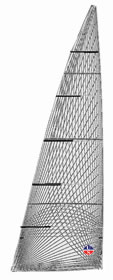
Main Sail Trim Techniques
How to optimize power and pointing
Trimming your Ullman main sail can be made simple by following these rules-of-thumb. Use these as a starting point and experiment with small changes to see what works best for your boat.
- Mainsheet Trim Tips
- Outhaul and Reef Tension
- Backstay Tension
- Vang Tension
 Main sheet and Traveler
Main sheet and Traveler
The two most important guides for trimming a mainsail upwind are to keep the boom on the center line of the boat, and the top batten (three batten main) or the second batten down (four batten main) parallel to the boom. At this point, the leech telltale at the appropriate batten should flow. If it doesn’t, you should twist the sail off more by easing the sheet and pulling the traveler further to windward.
Leach tension
More leech tension closes the leech which allows the boat to point higher. But when you trim past the point of stall, where the top telltale (three batten main) or second telltale down (four batten main) stops flying, the boat will start to slow down. As the boat begins to be overpowered, the traveler should be eased down to reduce weather helm and keep the boat at less than 25 degrees of heel. As the traveler is eased, you will begin to develop back-wind. This is not a problem. In puffy wind, the traveler should be played aggressively. Choppy water usually requires a little more twist in the leech than flat water so you should pull the traveler higher and ease the sheet.
Outhaul and flattening reef
In underpowered conditions upwind, the outhaul should be adjusted to keep the shelf half open. When all crew members are on the weather rail, the shelf should be closed. If you are equipped with a flattening reef, and are having to ease the traveler frequently in the puffs, you should put in the flattening reef. The flattener is a ring in the leech just above the clew. It is independent of the cunningham and will remove boom droop and fullness from the bottom quarter of the sail. It does not have to be entirely taken up, but rather can be tensioned as more flattening is required. Off-wind, both outhaul and flattener should be eased to fully open the shelf.
Cunningham and halyard tension adjustments
Cunningham and main halyard adjust the luff tension which affects the position of draft or maximum fullness in your main. As a general rule, the draft should be 50% aft from the luff. In underpowered conditions, you should have horizontal wrinkles on the luff to allow the draft to stay in its designed position. As the wind increases, the draft will move aft due to mast bend and cloth stretch, so you need to add luff tension to hold it at 50%. In choppy water, the draft would be a bit further forward (40-45%) for better acceleration. In very flat water and a good breeze, the draft can be allowed to slide aft to 60%.
Off-wind, be sure to ease the Cunningham right off.
Backstay
In traditional masthead rigs with no running backstays, the permanent backstay controls both mastbend and headstay sag. Mastbend is the primary adjuster of mainsail fullness. As wind increases, so should backstay tension. We strongly recommend a powerful and “easy to use” backstay adjuster.
If your masthead rig has running backstays, these are used to control mastbend. They also have an effect on headstay sag. At a given permanent backstay tension, more “runner” will straighten the mast (making the main fuller) and remove headstay sag.
On a fractional rig, permanent backstay controls mastbend and the runner (attached at the hounds) controls the headstay sag. A fractional rig may also have a checkstay which controls lower mastbend much the way runners on a masthead rig work.
Whatever your rig configuration, you need to make your main flatter as the wind increases. Choppier water requires a bit fuller sail for a given wind strength. You should also mark all adjustments so you can consistently reproduce fast settings.
Off the wind, the permanent backstay should be eased right off unless you are power reaching, when about half of full tension should be carried to depower the sail and support the rig.
Vang Tension
If you have a powerful vang, you can use it to induce lower mastbend if you want to flatten the main entry down low. In general, this is not necessary on most big boats. Off the wind, the best rule is to keep the top or second batten down (3 or 4 batten main, respectively) parallel to the boom. Close or beam reaching, you can also watch the top or second telltale down, as appropriate, and keep it flowing. On a power reach where you are on the edge of a broach, keep a hand on the vang to dump it off if the rudder feels as though it is stalling. Downwind in big waves and wind, you can help stop oscillation by “overvanging” and hooking the leech.
For more detailed information on setting your Ullman main, call Ullman Sails at 619-871-2171 or contact us.

